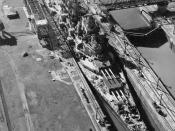The idea for a sea-level canal has been around since the 16th century when canals were first developed. The Panama Canal, an artificial waterway across the Isthmus of Panama in Central America, connects the Atlantic and the Pacific oceans. Its course is north-south, and the Pacific border is to the east of the Atlantic end. At the time of its opening it was universally acknowledged as the greatest engineering feat of the modern age, and it is still so regarded by many observers. The passage through this waterway shortens the trip from the Atlantic to the Pacific by 7,000 mi.
The first serious attempt to construct the Panama Canal began in 1881 and was undertaken by a private company. The original construction called for a sea-level channel without locks, but the project began to appear beyond the capability of the privately financed concern. The limiting costs resulted in the failure of this operation in 1889.
The United States acquired the rights to construct the canal in 1904 and began work in earnest, only this time with three sets of locks.
Since its construction the Panama Canal has accomplished much. About 32 ships pass through the canal daily. They pay an average of $28,000 for passage. Some massive ships pay tolls several times this amount. The fees are well spent, for the trip of some eight to ten hours through the canal saves many miles and many days of travel. An almost endless variety of products pass through the canal day after day. Over a million tons of oceangoing commercial cargo are shipped through the canal each year. The main commodities passing through the canal are petroleum and petroleum products. In 1915, the first year of operation, about 5 million tons of cargo were shipped through the Panama Canal...


